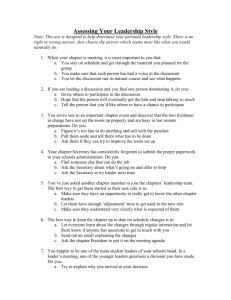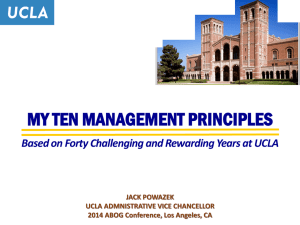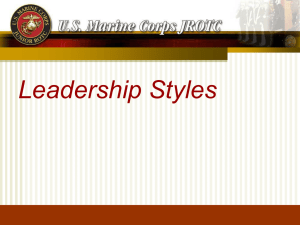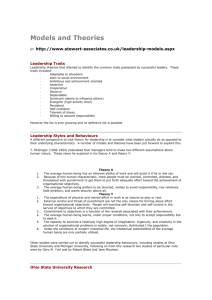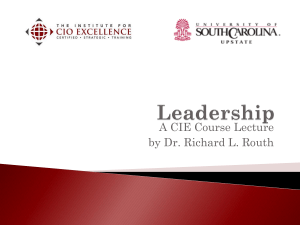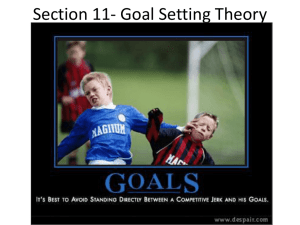Ch7 Influence Processes in organization
advertisement
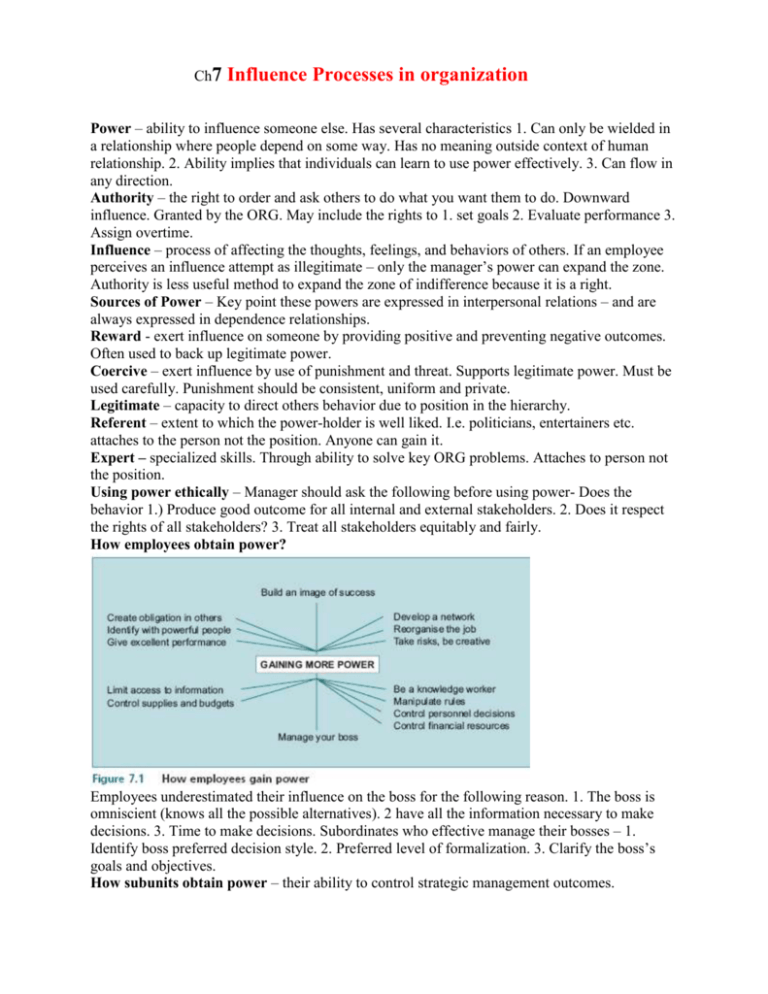
Ch7 Influence Processes in organization Power – ability to influence someone else. Has several characteristics 1. Can only be wielded in a relationship where people depend on some way. Has no meaning outside context of human relationship. 2. Ability implies that individuals can learn to use power effectively. 3. Can flow in any direction. Authority – the right to order and ask others to do what you want them to do. Downward influence. Granted by the ORG. May include the rights to 1. set goals 2. Evaluate performance 3. Assign overtime. Influence – process of affecting the thoughts, feelings, and behaviors of others. If an employee perceives an influence attempt as illegitimate – only the manager’s power can expand the zone. Authority is less useful method to expand the zone of indifference because it is a right. Sources of Power – Key point these powers are expressed in interpersonal relations – and are always expressed in dependence relationships. Reward - exert influence on someone by providing positive and preventing negative outcomes. Often used to back up legitimate power. Coercive – exert influence by use of punishment and threat. Supports legitimate power. Must be used carefully. Punishment should be consistent, uniform and private. Legitimate – capacity to direct others behavior due to position in the hierarchy. Referent – extent to which the power-holder is well liked. I.e. politicians, entertainers etc. attaches to the person not the position. Anyone can gain it. Expert – specialized skills. Through ability to solve key ORG problems. Attaches to person not the position. Using power ethically – Manager should ask the following before using power- Does the behavior 1.) Produce good outcome for all internal and external stakeholders. 2. Does it respect the rights of all stakeholders? 3. Treat all stakeholders equitably and fairly. How employees obtain power? Employees underestimated their influence on the boss for the following reason. 1. The boss is omniscient (knows all the possible alternatives). 2 have all the information necessary to make decisions. 3. Time to make decisions. Subordinates who effective manage their bosses – 1. Identify boss preferred decision style. 2. Preferred level of formalization. 3. Clarify the boss’s goals and objectives. How subunits obtain power – their ability to control strategic management outcomes. Scarcity (not enough resources), Uncertainty, centrality (center of authorization for all expenses), Absence of substitutes (no one can do the job). Uses and abuses of power – Playing politics 1. Approved methods and approved outcomes – (sanctioned outcomes) 2. Approved methods and unapproved outcomes (rules are followed but undesirable outcomes) 3. Unapproved methods and approved outcomes (e.g. production group hoarding supplies to ensure steady production) 4. Unapproved methods and unapproved outcomes How managers play politics? – 1. Create ORG change by whistle blowing (occurs when individual believes ORG is violating the terminal instrumental values or law. Whistleblowers usually have high ethical standards. In most cases have the best interest of the company in mind?) 2. Defeat rivals by creating line versus staff conflict. 3. Sponsorship and coalition building. (Gaining the favor of powerful individuals.) 4. Resist authority through insurgency (following the letter of the law. In a manner unintended by management. Hard to document and correct. Widespread practice should disturb management.) Managing the boss Leadership – power of an individual to guide the actions of another. Leaders advocate change, try new approached to problems. Leaders are different from managers but they can be the same person. Managers perform specific function, are responsible for the performance and productivity of subordinates. Leaders resist status quo and propose change, able to influence others to pursue their goals. Understanding the role of managers – Effects of downsizing and use of self-directed teams on certain managerial roles In fully delayered decentralized organization the managerial role of figurehead, leader, spokesperson have nearly vanished from day to day operations. Self-directed teams have taken over these tasks. Trait approach to leadership - leader himself has some influence on the outcomes of work and success of the ORG. Leader traits are referred to personal characteristics (physical, social background, intellectual, personality, work orientation, interpersonal skills). Other traits – logical thinking (putting ides into simpler forms, persuading others, explaining things in unique ways) persistence ( treating setbacks as small mistakes, working long hours, trying to succeed against odds) empowerment (getting people excited about goals, being energetic and enthusiastic, making subordinates believe they can achieve excellence) Self-Control (working under heavy pressure, remaining even-tempered, resisting intimidation) Weakness of Trait approach – failure to take into account the situation in which leadership occurs. Leadership is an influence process and can not occur the context of interpersonal relations. Leader traits are related to who gets promoted than who is an effective leader. Behavioral approach – importance of constancy and predictability of the leader behavior across leadership situation. Key thing is not what trait leader has but focusing on behavior that influences subordinate performance and satisfaction. Two fundamental leader behaviors 1. Initiating structure (behavior focus on group goals by 1. work procedures, 2.planning, assigning tasks. 3. Clarifying work roles. 4. Supervising 5. Asking for results._ and 2. Consideration. (Behavior which exhibit 1. approachability, 2. supportiveness, 3. maintenance of high morale, 4. concern for group welfare 5. collaborative work atmosphere. Focuses on self esteem and cohesiveness of group) When to use each behavior – 1.)When subordinates are experiencing time pressure, job ambiguity or external threat, satisfaction and performance increase under initiating structure leader behaviour.2 if the group’s task is perceived to be interesting and challenging by group members, then the need for consideration and initiating structure is reduced. 3 When the group’s goals and task are certain, consideration promotes satisfaction and initiating structure can cause dissatisfaction. Thus, under conditions of high task clarity, initiating structure becomes unnecessary and intrusive.4 if subordinates lack job performance knowledge or their jobs are vague, consideration has less relationship with satisfaction and performance than initiating structure. Kurt Lewin three leadership styles -1.) Autocratic (leader is strong, directive, controlling, enforcing of regulations and focused on outcomes) 2.) Democratic (Leader is collaborative, interactive, collegial and responsive to subordinates needs.) 3. Laissez-faire (leader is unwilling to accept the responsibilities). Style approach focuses on what leader do not what they like (trait). Behavioral approach also has problems as it does not address the fundamental issue of leadership as a cause or effect. If the leaders behavior causes the outcome or the subordinates behaviors. It does not address the leadership situation. Situational Leadership – integrative approach – leader’s traits and behaviors are considered in terms of the situation he confronts. Fiedler contingency theory – proposes that leader behavior interacts with the favorableness of the situation to determine the level of group effectiveness. Requires the measurement of the leader’s orientation to LPC (least preferred co-worker). Leaders who describe the LPC in warm terms (high LPC) are called relationship oriented. The high LPC leader is motivated to maintain good interpersonal relations with subordinates. The low LPC leader is task oriented and he believes that the poor performer has few redeeming qualities and describes the least preferred coworker in rejecting terms. The low LPC leader is motivated to get the tasks done and move on with the job and achieve goals. House’s path goal theory – Also called transactional theory (specifies how a leader exchanges rewards for performance and effort). Concerned with the situation which cause the leader behavior to be more effective. He believes that the leader’s main job is the clarification of pathways between subordinates performance and the rewards they value. Leader must develop following behaviors 1. Directive (work planning, setting performance standards) 2. Supportive (friendly, supporting, caring) 3. Participative (use subordinates idea’s for problem solving) 4. Achievement oriented. (Setting goals or subordinates and expecting them to achieve them)... This theory focuses on two aspects of leader ship situation 1. Looks at subordinates task abilities and need for achievement 2. Looks at environment factors (task clarity, routines, and challenge). Subordinates with strong achievement drive work well with achievement oriented leader Subordinates who prefer high structure perform best under directive leader. Subordinates who question task abilities respond to directive however they will find this behavior irritating they have high ability to perform task but time pressure to complete. If task are clear and work is routine – any leader behavior may be seen as intrusive. If tasks are challenging and ambiguous subordinates experience more satisfaction if leader combines directive and participative behavior. Leader reward and punishment behavior 1. Performance-contingent reward behavior – extent to which a leader used positive reinforces. Such as praise, recognition etc... Linked with higher levels of subordinate job performance and satisfaction. 2. 2. Contingent punishment behavior – extent to which leader uses discipline and punitive outcomes. (Reprimands, disapproval). 3. Non contingent reward behavior – extent to which a leader rewards a subordinate regardless of how well he does the job. 4. Non contingent punishment behavior – extent to which leader uses punitive means and reprimands – regardless of how well a subordinate performs. Has strong negative effect on job performance and satisfaction. New age of entrepreneurs is the creation of wealth by assuming risk through equity, time, or career commitment to add value to a product or service. Myths about entrepreneurship – 1. They are doers not thinkers. 2 are born not made 3. All you need is money. 4. All you need is luck. 5. Myth of entrepreneur’s profile. How organizations encourage entrepreneurial and innovation Begins with idea champion (employee who generated idea) here must be a sponsor (nurtures the concept and applies ORG resources. godfather – handles all the political obstacles. Makes resources available. Greenhouses protecting teams from outside interference. Summary Points Power is the ability to influence someone else. • Authority is the right to order or to ask others to do what you want them to do. It is bestowed by the position in the organizational hierarchy. Influence is the process of affecting the thoughts, feelings and behaviors of others. All employees have a zone of indifference, the range in which they perceive influence attempts to be legitimate and fair. Managers who use power ethically must communicate effectively and through their words and actions show respect for their subordinates. There are several sources of interpersonal power. Reward power, coercive power and legitimate power all adhere to the position held by the individual. They are a function of vertical placement in the hierarchy. Referent and expert power are forms of personal power which have little to do with placement in the hierarchy of the organization. Subunits in the organization gain power by 1) competing for resources, 2) managing organizational uncertainty, 3) occupying a central position in the flow of work and 4) eliminating substitutes for the subunit’s activities. Organizational politics refers to the management of influence to obtain ends not sanctioned by the organization or to obtain sanctioned ends through nonsanctioned means. Managers play politics by whistle blowing, sustaining line and staff conflict, building coalitions and finding sponsors and practicing insurgency. Whistle blowing behavior occurs when the organization’s values and practices violate an employee’s instrumental or terminal values. Upward management of the boss is both reasonable and necessary to sustain an effective superior– subordinate relationship. Leadership is the power of one individual to guide the actions of another. Management is understood as a set of interlocking roles: 1) interpersonal, 2) informational and 3) decisional. The study of leadership moves forward on three fronts: 1) trait theory; 2) behavioral style theory and 3) contingency theory. The trait theory emphasizes qualities of the leader. The behavioral style theory focuses on the actual behaviors of the leader. The contingency theory attempts to blend leader behaviors with the demands of the leadership situation. Behavioral style theory emphasizes two basic forms of leader behavior: 1) consideration refers to those behaviors which sustain the morale and cohesiveness of the work group and 2) initiating structure refers to directive behaviors which focus on achieving goals and clarifying work. Both leader behaviors are related to group performance and member satisfaction depending on: 1) external pressure, 2) nature of the task, 3) clarity of goals and 4) extent of performance feedback. Fiedler’s contingency theory tries to integrate the leader’s orientation to his least preferred Coworker and the favorableness of the leadership situation. The theory proposes that the situation is composed of: 1) leader–member relations, 2) leader’s position power and 3) task structure. The leader’s control of situational favorableness can be enhanced by changes in leader–member relations, position power and task structure. The path goal theory of leadership proposes that the leader’s job is the clarification of pathways between subordinates’ effort and performance, and between subordinates’ performance and the rewards they value. The leader can adopt: 1) directive, 2) supportive, 3) participative or 4) achievement oriented behavior to achieve the clarification noted. Characteristics of subordinates, tasks and the organization can function as neutralizers and substitutes for leadership. Leader reward and punishment behaviors consist of four dimensions. The leader’s use of nonperformance contingent punishment behavior will undermine his position the fastest. Entrepreneurs are special types of leaders who create wealth by assuming risk. Entrepreneurship consists of skills which can be learned. They differ from administrators in their orientation to strategy, opportunity exploitation, decision-making, resource allocation and reward practices. Entrepreneurial behavior can be learned by employees. The organization must create the roles of: 1) idea champion, 2) sponsor and 3) godfather to ensure a culture that encourages entrepreneurship. Organizations must also protect creative groups from organizational bureaucracy by creating ‘greenhouses’ or ‘reservations’.
